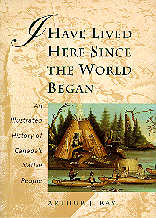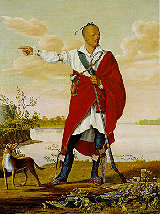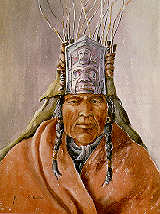


|
I Have Lived Here Since the World Began: An Illustrated
History of Canada's Native People.
Arthur J. Ray.
Subject Heading:
Grades 11 and up / Ages 16 and up. **** /4
|

excerpts:
It has happened very often, that where we were most welcome, where we baptized the most people, there was in fact where they died the most; and, on the contrary, in the cabins to which we were denied entrance, although they were sometimes sick to extremity, at the end of a few days one saw every person prosperously cured. We shall see in heaven the secret, but ever adorable, judgments of God therein.
- Father Gabriel Lalemant, 1640
We know from bitter experience that others do not know what is best for us. We are engaged in a fight we will never give up, a fight to implement the policies we know will help us lift ourselves above our present problems. We hope for and welcome the support of other people in Canada in that struggle.Canadian historian Arthur J. Ray, author of Indians and the Fur Trade (1974) and The Fur Trade in the Industrial Age (1990), has undertaken a daunting task in this elegantly written one volume work. This is history on a grand scale, an attempt to synthesize 10,000+ years of Native Canadian economic life into a form that is accessible to a general readership.
- George Eurasmus, Co-chair of the Royal Commission on Aboriginal Peoples, 1989

In the introductory remarks, Ray notes that new general histories "by and about" Native people focus on ideological, religious, social, and political aspects of history. However, he wants to demonstrate that changes in these areas developed subsequent to changes in economic patterns. As well, he shows that, since the first contact, white economic policy consistently reflected a dedicated purpose to marginalize Aboriginal people and destroy their culture.
At the "time of contact", the indigenous peoples enjoyed sophisticated advantages over the "intruder", advantages that made them valuable resources. Natives knew the territory; they had control over the resources; they had established trade-links to other peoples in the interior. Unfortunately, for the Native people, it did not take long for this relationship to be reversed. Traders learned the land and established their own networks, and soon the Natives became laborers instead of partners in the enterprise.

Through an examination of the modern fur trade, the industrial fishery and western agricultural policy, Ray shows how Natives were systematically disenfranchised and not allowed to compete in the market place on equal terms with entrepreneurs and settlers.
Governments began promoting colonization and industrial development. Indigenous people were seen either as an economic burden whose way of life and spiritual beliefs were incompatible with white materialistic ideology or as an economic threat to white control of agriculture and industry. Consequently, Canada's insidious course of action, although always promoted under the pretense of benevolent paternalism, has been the spiritual destruction of the First People through the residential school and reserve systems.
This excellent work will be an "eye-opener" for most young students of Canadian history. The mistaken belief that Canada has not oppressed and actively sought the destruction of the First Nations might finally be put to rest with Professor Ray's indictment of the federal government and the Department of Indian and Northern Affairs.
Highly Recommended.
Ian Stewart is a member of the Winnipeg Public Library Board and works at Lord Nelson School in Winnipeg, MB.

To comment on this title or this review, send mail to cm@umanitoba.ca.
Copyright © 1997 the Manitoba Library Association. Reproduction for personal use is permitted only if this copyright notice is maintained. Any other reproduction is prohibited without permission.
Published by
The Manitoba Library Association
ISSN 1201-9364
TABLE OF CONTENTS FOR THIS ISSUE - JUNE 20, 1997.
AUTHORS | TITLES | MEDIA REVIEWS | BOOKSHELF | BACK ISSUES | SEARCH | HOME